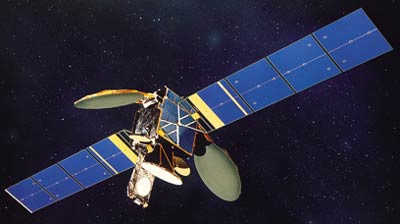N-Star a, b (original) (raw)
Please make a donation to support Gunter's Space Page.
Thank you very much for visiting Gunter's Space Page. I hope that this site is useful and informative for you.
If you appreciate the information provided on this site, please consider supporting my work by making a simple and secure donation via PayPal. Please help to run the website and keep everything free of charge. Thank you very much.

N-Star a [SSL]
Two Space Systems/Loral (SS/L) satellites with the highest capacity of any commercial payloads in space were delivered on orbit in 1995 and 1996 and are now providing a variety of fixed and mobile domestic communications services to customers throughout Japan. These satellites, N-STAR-a and -b, replace the service of the SS/L CS satellites, which have now exceeded their expected lifetimes, and will also provide significant new services, which range from providing alternate routes for telephony, to emergency communications, to marine and terrestrial mobile services, and ISDN. The N-STARs were built for Nippon Telegraph and Telephone (NTT) and NTT Mobile Communication Network Inc. (NTT DoCoMo). Dubbed “switchboards in the sky,” for their wide range of abilities, these 26-transponder satellites each carry five separate communications payloads operating in four frequency bands:
- The S-band payload provides terrestrial and maritime mobile communications services in four S-band antenna beams via a radio-frequency feeder link at C-band. Dual-mode phones enable users to connect to either conventional cellular or satellite service.
- The Ka-band multibeam payload provides satellite switched time-division multiple-access (SS-TDMA) communications for the main Japanese islands and Okinawa. This payload is a dynamic switch, programmable by commands from telemetry uplinks to switch traffic from any of eight uplink beams into any of three downlink beams as needs and conditions change.
- The Ka-band shaped-beam payload provides five 100 MHz wide channels, operating as a conventional turnaround repeater.
- The C-band payload provides six 72 MHz channels, one of which serves as a dedicated feeder link for the S-band mobile system.
- The Ku-band payload provides eight 54 MHz channels, each using a high-power TWTA as its final amplifier. One of the channels serves as a backup to the C-band feeder link for the S-band mobile system.
In N-STAR, SS/L delivered a turnkey package on orbit that included design and construction of the satellite, procurement of launch services and insurance, orbit raising, and in-orbit checkout. The N-STARs were launched aboard Ariane-44P H10-3 vehicles.
SS/L's SSL-1300 platforms are designed to achieve long useful orbital life – in this case 10 years – through use of a bipropellant propulsion system and a momentum-bias system for excellent stationkeeping and orbital stability. Solar arrays and nickel-hydrogen batteries provide uninterrupted electrical power.
| Nation: | Japan |
|---|---|
| Type / Application: | Communication |
| Operator: | NTT-DoCoMo |
| Contractors: | Space Systems/Loral (SS/L) |
| Equipment: | 5 × 100 MHz bandwidth Ka-band transponders, 6 × 200 MHz bandwidth Ka-band transponders, 8 × 54 MHz bandwdith Ku-band transponders, 6 × 72 MHz bandwidth C-band transponders, 2 beams S-band 10 MHz, 2 beams S-band 12 MHz |
| Configuration: | SSL-1300 |
| Propulsion: | R-4D-11 |
| Power: | 2 deployable solar arrays, batteries |
| Lifetime: | 10 years |
| Mass: | 3400 kg (2050 kg BOL, 1617 kg dry) |
| Orbit: | GEO |
| Satellite | COSPAR | Date | LS | Launch Vehicle | Remarks |
|---|---|---|---|---|---|
| N-Star a | 1995-044A | 29.08.1995 | Ko ELA-2 | Ariane-44P H10-3 | |
| N-Star b | 1996-007A | 05.02.1996 | Ko ELA-2 | Ariane-44P H10-3 |